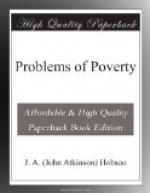Outdoor workers earn from 6s. to 12s., but where more than 10s. is earned, the woman is generally assisted by one or more of her children. Generally speaking, the most miserably paid work is that in trades where most of the work is done by out-door workers. Such is the lowest stratum of the “vest and trousers” trade, where English women undertake work rejected by the lowest class of Jew workers, and the shirt-making trade, which, in the opinion of the Lords’ Committee, “does not appear to afford subsistence to those who have no other employment.” In these and other trades of the lowest order, 6s. a week is a tolerably common wage for a work-woman of fair skill to net after a hard week’s work, and there are many individual cases where the wage falls far below this mark.
It is true that the work for which the lowest wages are paid is often that of learners, or of inefficient work-women; but while this may be a satisfactory “economic” explanation, it does not mitigate the terrible significance of the fact that many women are dependent on such work as their sole opportunity of earning an honest livelihood.
Sec. 3. Irregularity of Employment.—As the wages of women are lower than those of men, so they suffer more from irregularity of employment. There are two special reasons for this.
[Greek: a]. Many trades in which women are employed, depend largely upon the element of Season. The confectionery trade, one of the most important, employs twice as many hands in the busy season as in the slack season. Match-makers have a slack season, in which many of them sell flowers, or go “hopping.” Laundry work is largely “season” work. Fur-sewing is perhaps the worst example of the terrible effect of irregular work taken with low wages. “For several months in the year the fur-sewers have either no work, or earn about 3s. or 4s. a week, and many of these work in overcrowded insanitary workshops in the season. Fur-sewing is the worst paid industry in the East End, with absolutely no exceptions."[35]
[Greek: b]. Fluctuations in fashion affect many women’s trades; in particular, the “ornamental” clothing trades, e.g. furs, feathers, trimmings, etc.
Employers in these slack times prefer generally to keep on the better hands (on lower wages), and to dismiss the inferior hands.
These “natural” fluctuations, added to ordinary trade irregularities, favour the employment of “outdoor” workers in sweaters’ dens or at home, and require in these trades, as conducted at present, the existence of an enormous margin of “casual” workers. These two chief factors in the “sweating” problem, sub-contract and irregular home-work, are far more prevalent in female industries than in male.
Sec. 4. Hours of Labour in Women’s Trades.—The Factory Act is supposed to protect women engaged in industrial work from excessive hours of labour, by setting a limit of twelve hours to the working day, including an interval of two hours for meals.




